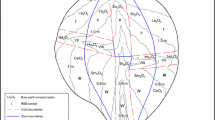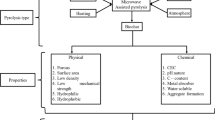Abstract
Purpose
This study aimed to explore the potential feasibility of magnetite powder as an erosion tracer for national-scale soil erosion monitoring in China.
Materials and methods
This study evaluated the effectiveness of silt-sized magnetite powder, a magnetic erosion tracer, in four representative erodible soils in China with distinct textures (from sandy loam to silty clay). The χlf values of different magnetic tracer-tagged aggregate size ranges (> 0.05 mm) were similar based on dry aggregate analysis.
Results and discussion
Simulated long-term leaching tests showed that the tracer had low mobility in soil profiles. The simultaneous separation of the tracer and tested soils under surface flow scouring conditions indicates that the tracer exhibited good bonding ability with different soils.
Conclusions
These findings indicate that magnetite powder is suitable for erosion monitoring in China. This method may be extended to other regions over the world.




Similar content being viewed by others
References
Armstrong A, Quinton JN, Maher BA (2012) Thermal enhancement of natural magnetism as a tool for tracing eroded soil. Earth Surf Process Landf 37:1567–1572
Dearing J (1994) Environmental magnetic susceptibility, using the Bartington MS2 system. Chi Publishers, Kenilworth
Evans M, Heller F (2003) Environmental magnetism: principles and applications of enviromagnetics. Academic Press, San Diego
Guzmán G, Barrón V, Gómez JA (2010) Evaluation of magnetic iron oxides as sediment tracers in water erosion experiments. Catena 82:126–133
Guzmán G, Vanderlinden K, Giráldez JV, Gómez JA (2013) Assessment of spatial variability in water erosion rates in an olive orchard at plot scale using a magnetic iron oxide tracer. Soil Sci Soc Am J 77:350–361
Hu G, Dong Y, Wang H, Qiu X, Wang Y (2011) Laboratory testing of magnetic tracers for soil erosion measurement. Pedosphere 21:328–338
Hudson N (1993) Field measurement of soil erosion and runoff. FAO Soils Bulletin vol 68. FAO, Rome, Italy
Hudson N (1995) Soil conservation. Iowa State University Press, Ames
Institute of Soil Science in Nanjing (1986) Soil atlas of China. Sinomap press, Beijing (in Chinese)
ISSS/ISRIC/FAO (1998) World reference base for soil resources. Rome
Jordanova N (2016) Soil magnetism: applications in pedology, environmental science and archeology, 1st edn. Academic Press, San Diego
Lal R (1994) Soil erosion research methods, 2nd edn. Soil and Water Conservation Society, Ankeny
Lal R (2005) Soil erosion and carbon dynamics. Soil Tillage Res 81:137–142
Liu P, Tian J, Zhou P, Yang M, Ju T (2001) Experimental study on soil erosion by stable rare earth element tracer method. Rare Earth 22:37–40 (in Chinese with English abstract)
Liu P, Tian J, Zhou P, Yang M, Shi H (2004) Stable rare earth element tracers to evaluate soil erosion. Soil Tillage Res 76:147–155
Liu L, Huang M, Zhang K, Zhang Z, Yu Y (2018) Preliminary experiments to assess the effectiveness of magnetite powder as an erosion tracer on the Loess Plateau. Geoderma 310:249–256
Montanarella L (2015) Agricultural policy: govern our soils. Nature 528:32–33
Mullins C (1977) Magnetic susceptibility of the soil and its significance in soil science–a review. J Soil Sci 28:223–246
National Soil Census Office (1998) China soil. China Agriculture Press
Nearing MA, Xie Y, Liu B, Ye Y (2017) Natural and anthropogenic rates of soil erosion. Int Soil Water Conserv Res 5:77–84
Olson K, Gennadiyev A, Jones R, Chernyanskii S (2002) Erosion patterns on cultivated and reforested hillslopes in Moscow Region, Russia. Soil Sci Soc Am J 66:193–201
Olson KR, Gennadiyev AN, Golosov VN (2008) Comparison of fly-ash and radio-cesium tracer methods to assess soil erosion and deposition in Illinois landscapes (USA). Soil Sci 173:575–586
Parsons AJ, Foster IDL (2011) What can we learn about soil erosion from the use of Cs-137? Earth-Sci Rev 108:101–113
Parsons AJ, Wainwright J, Abrahams AD (1993) Tracing sediment movement in interrill overland flow on a semi-arid grassland hillslope using magnetic susceptibility. Earth Surf Process Landf 18:721–732
Ritchie J, Ritchie C (2007) Bibliography of publications of Cs-137 studies related to erosion and sediment deposition. http://www.ars.usda.gov/Main/docs.htm?docid=15237. Accessed 21 July 2016
Soil Survey Staff (1999) Soil taxonomy (2nd Edition). Agriculture Handbook No. 436, Washington DC, USA
SPSS Inc (2008) SPSS Statistics for Windows, Version 17.0. SPSS Inc., Chicago
Stroosnijder L (2005) Measurement of erosion: is it possible? Catena 64:162–173
Tang K (2004) Soil and water conservation in China. Science Press, Beijing (in Chinese)
Thompson R, Oldfield F (1986) Environmental magnetism. Allen & Unwin, London
Toy TJ, Foster GR, Renard KG (2002) Soil erosion: processes, prediction, measurement, and control. John Wiley and Sons Ltd, Hoboken
Ventura E, Nearing MA, Norton LD (2001) Developing a magnetic tracer to study soil erosion. Catena 43:277–291
Ventura E, Nearing MA, Amore E, Norton LD (2002) The study of detachment and deposition on a hillslope using a magnetic tracer. Catena 48:149–161
Walling D, He Q, Whelan P (2003) Using Cs-137 measurements to validate the application of the AGNPS and ANSWERS erosion and sediment yield models in two small Devon catchments. Soil Tillage Res 69:27–43
Wheatcroft RA, Olmez I, Pink FX (1994) Particle bioturbation in Massachusetts Bay: preliminary results using a new deliberate tracer technique. J Mar Res 52:1129–1150
Yang M, Tian J, Liu P (2006) Investigating the spatial distribution of soil erosion and deposition in a small catchment on the Loess Plateau of China, using Cs-137. Soil Tillage Res 87:186–193
Zapata F (2002) Handbook for the assessment of soil erosion and sedimentation using environmental radionuclides. Kluwer Academic Publishers, Dordrecht
Zhang XC, Friedrich JM, Nearing MA, Norton LD (2001) Potential use of rare earth oxides as tracers for soil erosion and aggregation studies. Soil Sci Soc Am J 65:1508–1515
Zhang XC, Nearing MA, Polyakov VO, Friedrich JM (2003) Using rare-earth oxide tracers for studying soil erosion dynamics. Soil Sci Soc Am J 67:279–288
Zhang JH, Su ZA, Nie XJ (2009) An investigation of soil translocation and erosion by conservation hoeing tillage on steep lands using a magnetic tracer. Soil Tillage Res 105:177–183
Zhang XC, Zhang GH, Wei X (2015) How to make Cs-137 erosion estimation more useful: an uncertainty perspective. Geoderma 239–240:186–194
Zhang XC, Nearing MA, Garbrecht JD (2017) Gaining insights into interrill erosion processes using rare earth element tracers. Geoderma 299:63–72
Zhu X, Lin J, Dai Q, Xu YY, Li HD (2019) Evaluation of forest conversion effects on soil erosion, soil organic carbon and total nitrogen based on Cs-137 tracer technique. Forests 10:433
Funding
This work was funded by the National Natural Science Foundation of China (Grant No. 41701310, 41301301), the Strategic Priority Research Program of Chinese Academy of Sciences, the Chinese Academy of Sciences (CAS: XDB40020300) “Light of West China” Program, and China Postdoctoral Science Foundation (Grant No. 2016 M602884).
Author information
Authors and Affiliations
Corresponding author
Additional information
Responsible editor: Yi Jun Xu
Publisher’s note
Springer Nature remains neutral with regard to jurisdictional claims in published maps and institutional affiliations.
Rights and permissions
About this article
Cite this article
Liu, L., Liu, H., Fu, S. et al. Feasibility of magnetite powder as an erosion tracer for main soils across China. J Soils Sediments 20, 2207–2216 (2020). https://doi.org/10.1007/s11368-020-02574-7
Received:
Accepted:
Published:
Issue Date:
DOI: https://doi.org/10.1007/s11368-020-02574-7




